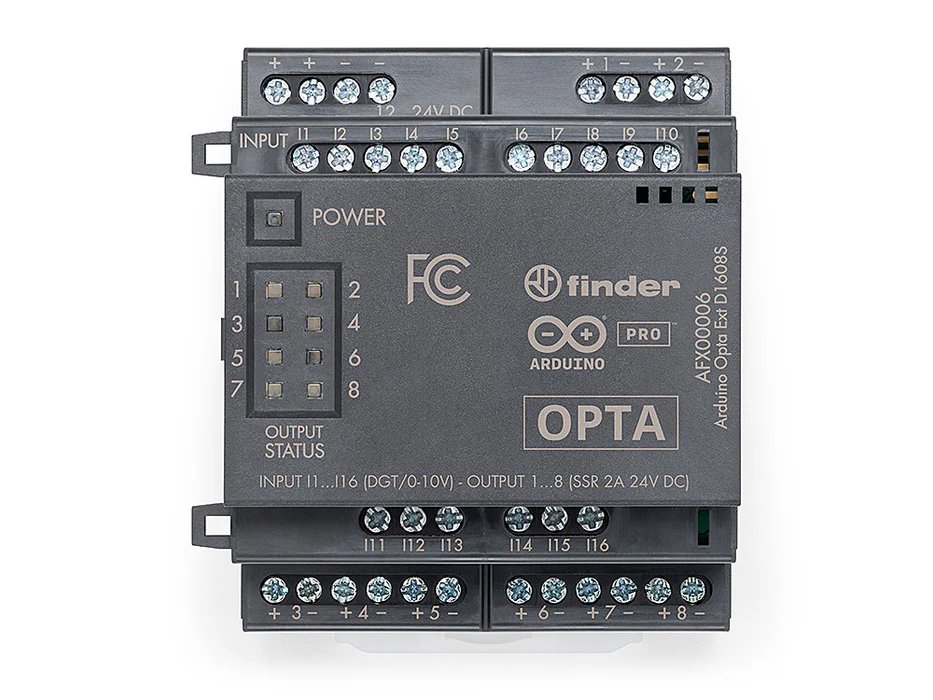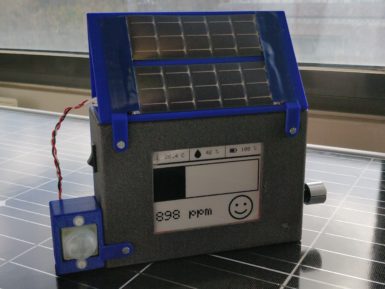
Arduino Pro Opta Ext D1608S
The snap-on expansion module to enhance Arduino Opta’s applications with the addition of 16 programmable voltage inputs and 8 solid-state relays.
Overview
Arduino Pro Opta Ext D1608S enhances your Arduino Opta’s real-time control, monitoring and predictive maintenance applications with the addition of 16 programmable voltage inputs and 8 solid-state relays 24 VDC 2A.
Just snap on the module to extend your system’s capabilities flexibly and quickly, and manage the new I/Os from the Opta base unit seamlessly, taking advantage of the open and widely known Arduino ecosystem or PLC IDE IEC 61131-3 programming environment.
Key benefits:
- Flexible inputs: 16 new inputs for your applications per each expansion added, programmable as digital 0-24 VDC or analog 0-10 V.
- Powerful outputs: 8 solid-state relays offering 24 VDC for 2A each.
- Up to 5 snap-on modules can be managed to multiply and mix a set of I/Os with seamless detection: snap them right next to your Opta base module and use the I/Os as native Opta resources.
- Extend your hardware capabilities while keeping programming accessible, by using the Arduino IDE with its wide range of ready-to-use sketches, tutorials and libraries.
- Put your new I/Os easily to work with the PLC IDE for IEC 61131-3 PLC languages, taking advantage of its low-code approach and pre-mapped resources.
- Extend the Opta’s benefits of real-time remote monitoring via intuitive Arduino Cloud dashboards and secure communication to a wider set of connected devices.
- Reliable by design, thanks to industrial certifications and Finder’s expertise in electronic devices.
- Easy DIN rail installation.
Applications
Opta’s digital expansions are ideal to increase the number of real-time control points in the manufacturing sector and in any building automation project.
The Opta Ecosystem is compatible with all major cloud providers – but choosing the simplicity of Arduino Cloud can really make a difference, for anyone who wants to build, customize and remotely manage their own dashboards.
Looking for a similar option?
Check out the Arduino Pro Opta Ext D1608E, to add 8 electromechanical relays 250 VAC 6A to your Opta-based solution.
Conformities
Resources for Safety and Products
Manufacturer Information
The production information includes the address and related details of the product manufacturer.
Arduino S.r.l.
Via Andrea Appiani, 25
Monza, MB, IT, 20900
https://www.arduino.cc/
Responsible Person in the EU
An EU-based economic operator who ensures the product's compliance with the required regulations.
Arduino S.r.l.
Via Andrea Appiani, 25
Monza, MB, IT, 20900
Phone: +39 0113157477
Email: support@arduino.cc
Documentation
Learn more
Get Inspired

Just a simple and enjoyable autonomous greenhouse

Humans are animals and like all animals, we evolved in mostly outdoor conditions where the air is nice and fresh. But modern society keeps most of us indoors the vast majority of the time, which could have negative health effects. There are many potential hazards, including a lack of sunlight and psychological effects, but CO2 may pose a more tangible risk. To keep tabs on that risk within classrooms, a team from Polytech Sorbonne built this small CO2 monitor. This CO2 monitor performs two functions: it shows anyone nearby the CO2 levels in the area and it uploads that data over LoRaWAN to a central hub that can track the levels across many locations. A school could, for example, put one of these CO2 monitors in every classroom. An administrator could then see the CO2 levels in every room in real time, along with historical records. That would alert them to immediate dangers and to long term trends. At the heart of this CO2 monitor is an Arduino MKR WAN 1310 development board, which has built-in LoRa® connectivity. It uses a Seeed Studio Grove CO2, temperature, and humidity sensor to monitor local conditions. To keep power consumption to a minimum, the data displays on an e-ink screen and an Adafruit TPL5110 timer only wakes the device up every ten minutes for an update. Power comes from a lithium-ion battery pack, with a DFRobot solar charger topping up the juice. It uploads data through The Things Network to a PlatformIO web interface. An Edge Impulse machine learning model detects anomalies, so it can sound a warning even if nobody is watching. The enclosure is 3D-printable.












